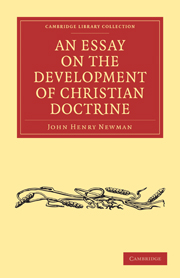Book contents
- Frontmatter
- ADVERTISEMENT
- Contents
- INTRODUCTION
- CHAPTER I ON THE DEVELOPMENT OF IDEAS
- CHAPTER II ON THE DEVELOPMENT OF CHRISTIAN IDEAS, ANTECEDENTLY CONSIDERED
- CHAPTER 3 ON THE NATURE OF THE ARGUMENT IN BEHALF OF THE EXISTING DEVELOPMENTS OF CHRISTIANITY
- CHAPTER IV ILLUSTRATIONS OF THE ARGUMENT IN BEHALF OF THE EXISTING DEVELOPMENTS OF CHRISTIANITY
- CHAPTER V ILLUSTRATIONS CONTINUED
- CHAPTER VI ILLUSTRATIONS CONTINUED
- CHAPTER VII ILLUSTRATIONS CONTINUED
- CHAPTER VIII ILLUSTRATIONS CONCLUDED
CHAPTER IV - ILLUSTRATIONS OF THE ARGUMENT IN BEHALF OF THE EXISTING DEVELOPMENTS OF CHRISTIANITY
Published online by Cambridge University Press: 16 May 2011
- Frontmatter
- ADVERTISEMENT
- Contents
- INTRODUCTION
- CHAPTER I ON THE DEVELOPMENT OF IDEAS
- CHAPTER II ON THE DEVELOPMENT OF CHRISTIAN IDEAS, ANTECEDENTLY CONSIDERED
- CHAPTER 3 ON THE NATURE OF THE ARGUMENT IN BEHALF OF THE EXISTING DEVELOPMENTS OF CHRISTIANITY
- CHAPTER IV ILLUSTRATIONS OF THE ARGUMENT IN BEHALF OF THE EXISTING DEVELOPMENTS OF CHRISTIANITY
- CHAPTER V ILLUSTRATIONS CONTINUED
- CHAPTER VI ILLUSTRATIONS CONTINUED
- CHAPTER VII ILLUSTRATIONS CONTINUED
- CHAPTER VIII ILLUSTRATIONS CONCLUDED
Summary
No one will be disposed to deny that the body of doctrine which at this day goes by the name of Catholic is at once the historical and the logical continuation of the body of doctrine so called in the eighteenth, in the seventeenth, in the sixteenth, and so back in every preceding century successively till we come to the first. Whether it be a corrupt development or a legitimate, conducted on sound logic or fallacious, the present so-called Catholic religion is the successor, the representative, and the heir of the religion of the so-called Catholic Church of primitive times.
Neither can any one, I think, deny, after following the line of thought which has just been brought to a conclusion, that the doctrines of which the present Catholic religion consists are primâ facie the correct, true, faithful, legitimate developments of the doctrines which preceded them, and not their corruptions; that a very strong case ought to be made out against that religion, to prove that it is materially corrupt, and not in its substance Apostolic.
We have now to proceed a step further,—to apply to these so-called Catholic doctrines, thus favourably recommended to our notice, the tests which have already been framed to distinguish between development and corruption; that is, in the fair and reasonable temper which is demanded us by this primâ facie likelihood of their fidelity to their originals.
- Type
- Chapter
- Information
- An Essay on the Development of Christian Doctrine , pp. 203 - 269Publisher: Cambridge University PressPrint publication year: 2010First published in: 1845



